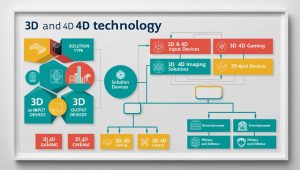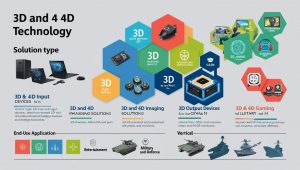The North American 3D & 4D technology market is witnessing rapid growth, driven by groundbreaking advancements in 3D and 4D technologies across various industries. From entertainment and gaming to healthcare, manufacturing, and education, 3D and 4D technologies are revolutionizing how businesses operate and interact with consumers. As these technologies continue to evolve, their applications are becoming increasingly diverse, offering new levels of precision, immersion, and interactivity. The growing demand for immersive experiences, real-time simulations, and highly accurate modeling is fueling the market’s expansion, making it one of the most dynamic segments in the technology sector.

3D and 4D Technology Industry
Key Drivers of Market Growth
Several factors are contributing to the accelerating growth of the North American 3D and 4D technology market. One of the most prominent drivers is the rapid adoption of 3D technologies in the entertainment and gaming industries. With the increasing popularity of 3D movies, video games, and virtual reality experiences, the demand for cutting-edge 3D hardware and software has surged. The 4D technology market, particularly in the field of simulation and real-time rendering, is also expanding as businesses strive to offer immersive, multi-sensory experiences.
In addition to entertainment, the healthcare sector is a significant driver of 3D and 4D technology adoption. The use of 3D imaging for medical scans and procedures, as well as 3D printing for creating prosthetics, surgical models, and even organ replicas, is transforming healthcare delivery. Furthermore, 4D technology is being used in medical training simulators, where real-time interaction enhances the learning experience for medical professionals.
Download PDF Brochure @ https://www.marketsandmarkets.com/pdfdownloadNew.asp?id=646
The manufacturing and automotive industries are also benefiting from these technologies. 3D printing, or additive manufacturing, allows manufacturers to prototype products quickly and efficiently, reducing costs and time-to-market. This capability is particularly valuable in industries like aerospace, automotive, and consumer goods, where precision and innovation are paramount. Additionally, 4D technology, which involves dynamic simulations and interactive modeling, is enabling manufacturers to create more robust designs and test scenarios in real-time, enhancing both product development and quality control processes.
Applications and Industry-Specific Uses
-
Entertainment & Gaming: 3D and 4D technologies are integral to the entertainment industry, where they provide an enhanced and immersive user experience. The proliferation of 3D films, video games, and virtual reality (VR) applications has led to widespread adoption of 3D displays, 3D rendering, and interactive systems. 4D technologies further enhance these experiences by adding real-time interactive elements such as motion, vibrations, and scent, making entertainment even more engaging.
-
Healthcare: The use of 3D printing in the healthcare sector is transforming medical practices. Surgeons can now use 3D-printed models of organs or bones to plan surgeries, while 3D imaging and diagnostics allow for better understanding and visualization of complex anatomical structures. 4D technology is also helping in training simulations, allowing medical professionals to interact with dynamic models that provide real-time feedback, enhancing their skills.
-
Manufacturing & Automotive: Additive manufacturing (3D printing) is enabling manufacturers to streamline production processes, lower material costs, and produce highly customized parts. 3D models are used to simulate designs, while 4D technology assists in testing real-time responses to different conditions. In the automotive industry, these technologies are integral to creating prototypes and improving product designs, significantly reducing time and cost in development.
-
Education & Training: 3D and 4D technologies are increasingly being used in education, particularly in STEM fields. Students can interact with complex scientific concepts and structures through 3D models, while virtual and augmented reality allow for hands-on learning experiences that were once impossible. Additionally, 4D training tools are helping students and professionals engage in simulations with real-time adjustments, offering an immersive learning environment.

3D and 4D Technology Industry
Technological Advancements and Future Outlook
North America’s 3D & 4D technology market is experiencing continual innovations that are enhancing the capabilities of both 3D and 4D systems. Advances in augmented reality (AR) and virtual reality (VR), coupled with high-definition 3D displays and powerful computing algorithms, are pushing the boundaries of what’s possible in these fields. The integration of artificial intelligence (AI) and machine learning (ML) with 3D and 4D technology is opening new frontiers for automation, real-time decision-making, and enhanced user experiences.
For example, 3D printing is advancing beyond traditional plastic materials to incorporate metal, ceramics, and bio-materials, enabling industries to create more durable and functional products. In the realm of 4D technology, real-time interactivity combined with haptic feedback systems is enhancing how users engage with virtual environments, whether for entertainment, training, or product design.
As industries continue to explore new possibilities, the North American 3D and 4D technology market is expected to grow at a robust rate. From creating customized medical devices and manufacturing prototypes to offering unprecedented gaming experiences and virtual education, the applications of these technologies are vast and expanding.
The North American 3D & 4D technology market is poised for significant expansion, driven by innovation, industry-specific applications, and growing consumer demand for immersive and interactive experiences. The convergence of technologies such as VR, AR, AI, and 3D printing is enhancing the capabilities of 3D and 4D systems, making them indispensable tools across multiple sectors. As the market continues to evolve, businesses and consumers alike will benefit from these advancements, which promise to redefine industries and daily life.
